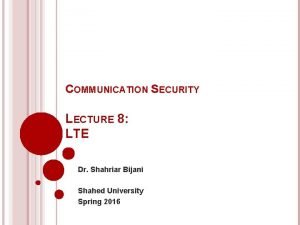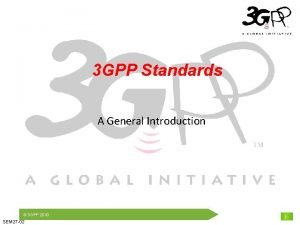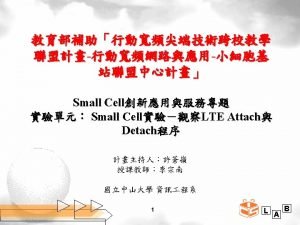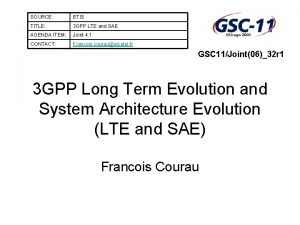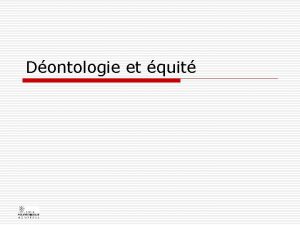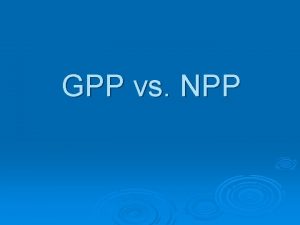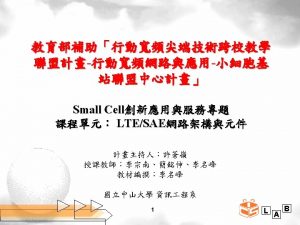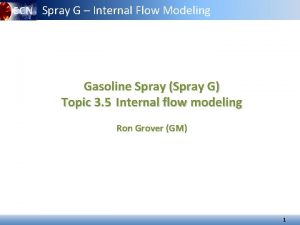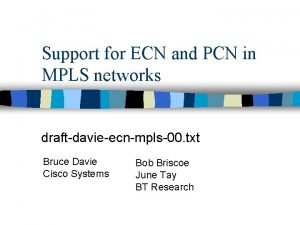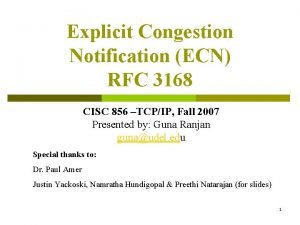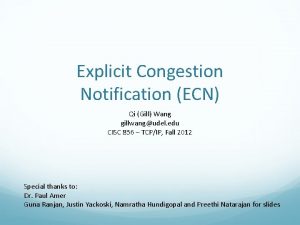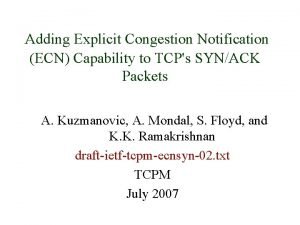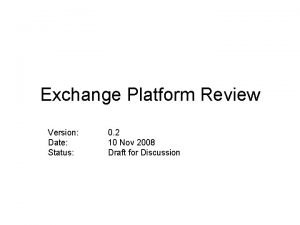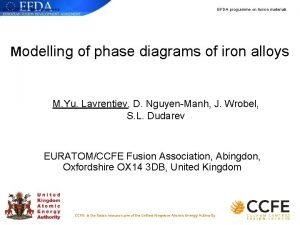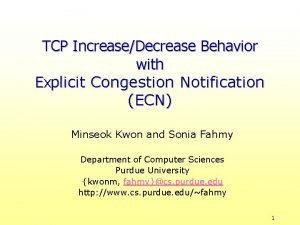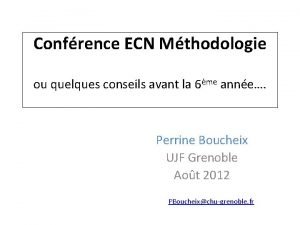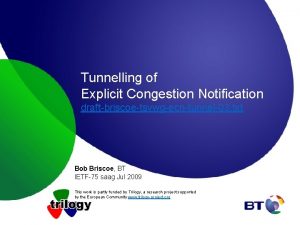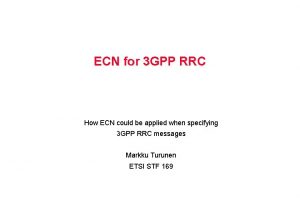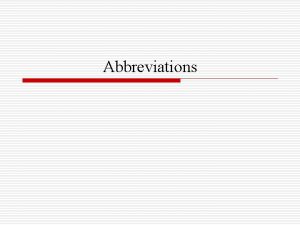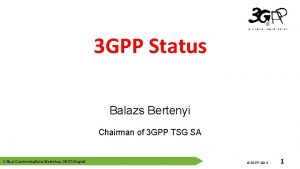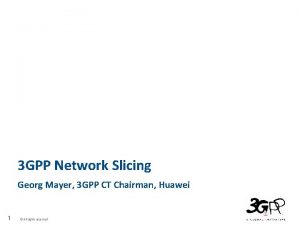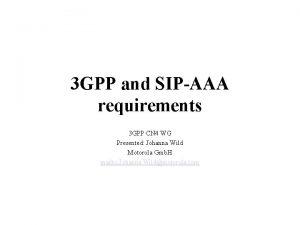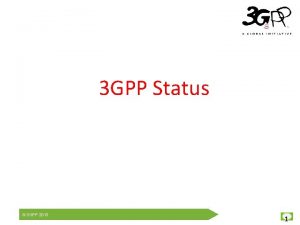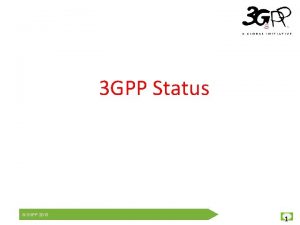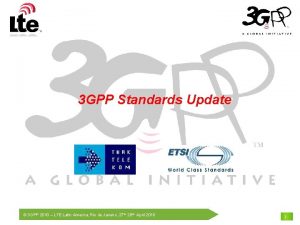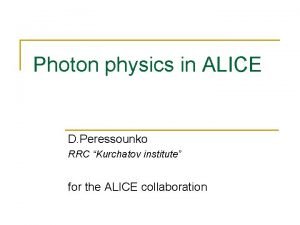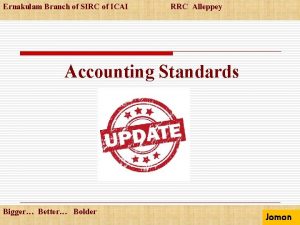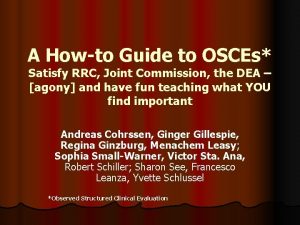ECN for 3 GPP RRC How ECN could










































- Slides: 42

ECN for 3 GPP RRC How ECN could be applied when specifying 3 GPP RRC messages Markku Turunen ETSI STF 169

Contents • • Introduction RRC message requirements Problems with the current definitions Solutions • • Addition of new messages New message versions

Introduction • • Purpose • To show what kind of improvements can be made concerning the current RRC message definitions • To show ECN can be used to simplify and clarify message definitions Note • • Minor details of the ECN examples might be revised in the future The ECN examples use features presented in the ballot comments

RRC message requirements • Encoded messages must be compact • Extensibility • New messages - addition shall have no effect on old messages - minimum overhead for new messages • New critical IEs => new message versions - receiver must be able to detect critical extensions - minimum overhead for new message versions • New non-critical IEs - minimum overhead for new non-critical IEs • • New values in IEs Compression/specialization of encodings

Problems with the current definitions • The vanilla ASN. 1 + PER do not fulfil the requirements • generic extensibility => more bits consumed for control information, no good Þ The requirements affect ASN. 1 definitions • • • Encoding specific issues are visible in message definitions The first message versions are manageable When messages are extended their complexity grows a lot

Solutions • Separate abstract message contents and encoding specific issues • The following slides show solution examples for the presented requirements

Addition of new messages • Requirements • • • It must be possible to add new channel specific messages Messages must be identified using as few bits as possible Current solution • There are explicit placeholders -- v 1 -- v 2 DL-DCCH-Message. Type : : = CHOICE { active. Set. Update Active. Set. Update, cell. Update. Confirm Cell. Update. Confirm, -- etc extension NULL extension } CHOICE { new. Message 1 New. Message 3, new. Message 4 New. Message 4, extension } } NULL

Addition of new msgs - Improvements • Simplify ASN. 1 definitions • • • Remove encoding oriented parts from abstract message definition Create a simple message wrapper type Separate message specific encoding definitions and generic encoding definitions • • All the messages types share the same structure => specify it only once Message identification is unique for each message type - fine-tune encoding if necessary

Addition of new msgs - ASN. 1 definitions • • Simple ASN. 1 definitions Special "extension" component • Used as a flag indicating presence of an extended message -- v 1 -- v 2 DL-DCCH-Message. Type : : = CHOICE { active. Set. Update Active. Set. Update, cell. Update. Confirm Cell. Update. Confirm, -- etc extension NULL } } new. Message 1 New. Message 3, new. Message 4 New. Message 4, extension NULL

Addition of new msgs - Generic structure • • Generic encoding structure for message types message identifier Variable length identifier field message contents The message determined by the id field Encoding of message identifier varies for different message types Encoding of message contents varies for different message types However the general structure is the same Þ Capture the general structure in a generic parameterized encoding structure Þ Provide message type specific parts as parameters

Addition of new msgs - Generic structure • "#RRC-Message. Type-struct" is an encoding structure • It specifies the bit-fields that comprise encoding of "RRC-Message. Type" Original choice of messages, e. g. "#DL-DCCH-Message. Type". #RRC-Message. Type-struct{< #Msgs >} : : = #SEQUENCE { aux-message. Id #RRC-Message. Identifier, message #Msgs } #RRC-Message. Identifier : : = #INT Message identifier bit-field Message contents bit-field(s)

Addition of new msgs - Generic structure • The "rrc-Message. Type-struct-encoding" is an encding object • It specifies how the bit-fields of "#RRC-Message. Type-struct" are encoded rrc-Message. Type-struct-encoding{< #Msgs, #RRC-Message. Identifier : msg. Id-encoding >} #RRC-Message. Type-struct{< #Msgs >} : : = { Encoding for the message identifier ENCODE STRUCTURE { aux-message. Id msg. Id-encoding, message choice-with-aux-determinant-encoding{< aux-message. Id >} STRUCTURED WITH per-seq-encoding } The message identifier is the selector for the message } The structure is otherwise encoded using normal PER

Addition of new msgs - Msg specific defs • Encoding definition for a message wrapper type • Replace encoding structure (bit-fields) with the generic structure - "#DL-DCCH-Message. Type" will be the value of the "#Msgs" parameter • Provide parameters for the generic encoding object - How message identifier is encoded d. L-DCCH-Message. Type-encoding #DL-DCCH-Message. Type : : = { REPLACE entire-structure WITH #RRC-Message. Type-struct Use this structure ENCODING d. L-DCCH-Message. Type-struct-encoding Use this encoding object } d. L-DCCH-Message. Type-struct-encoding{< #Msgs >} #RRC-Message. Type-struct{< #Msgs >} : : = rrc-Message. Type-struct-encoding{< #Msgs, rrc-message. Identifier-2 -encoding >} This encoding object specifies how message id is encoded

Addition of new msgs - Message id • "rrc-message. Identifier-2 -encoding" is an encoding object for message ids rrc-message. Identifier-2 -encoding #RRC-Message. Identifier : : = { USE #BITS MAPPING TO BITS { 0. . 1 TO '000'B. . '001'B, 000 - Message 1, 001 - Message 2 2 TO '01'B 01 - extensions } WITH self-delimiting-bits } rrc-message. Identifier-2 -2 -encoding #RRC-Message. Identifier : : = { USE #BITS MAPPING TO BITS { 0. . 1 TO '000'B. . '001'B, 2. . 3 TO '01000'B. . '01001'B, 000 - Message 1, 001 - Message 2 01000 - Message 3, 01001 - Message 4 4 TO '0101'B 0101 - extensions } WITH self-delimiting-bits }

Addition of new msgs - Summary • ASN. 1 definitions can be simplified • Generic encoding structure for the messages • • #RRC-Message. Type-struct Generic encoding for the bit-fields of the message structure • rrc-Message. Type-struct-encoding • Encoding of message identifiers can be separated and specialized as wanted • rrc-message. Identifier-2 -encoding • Only small amount of message type specific ECN definitions are needed • • d. L-DCCH-Message. Type-encoding - use replacement d. L-DCCH-Message. Type-struct-encoding - encoding for replacement

New message versions • Addition of new critical IEs creates new message versions • • E. g. v 1. 0 => v 2. 0 => v 3. 0 Addition of new non-critical IEs creates new message sub-versions • E. g. v 1. 0 => v. 1. 1 => 1. 2

New message versions • Current solution • Placeholders for critical and non-critical IEs Active. Set. Update : : = CHOICE { ies SEQUENCE { ies Active. Set. Update-v 1 -IEs, v 1. 0 Active. Set. Update-v 1 -IEs, non. Critical. Extensions SEQUENCE { non. Critical. Extensions ies SEQUENCE {} OPTIONAL v 1. 1 Active. Set. Update-v 1 -v 2 -exts, non. Critical. Extensions }, SEQUENCE {} OPTIONAL critical. Extensions NULL } OPTIONAL } }, critical. Extensions CHOICE { ies SEQUENCE { ies Active. Set. Update-v 2 -exts, non. Critical. Extensions SEQUENCE {} OPTIONAL }, critical. Extensions } } NULL v 2. 0

New msg versions - Improvements • Simplify ASN. 1 definitions • • • Make versioning explicit Group all sub-versions in a single version structure Make encoding definitions for messages and message versions • • All messages share the same structure Identification of message versions is the same for all the messages Þ Specify them only once

New msg versions - ASN. 1 defs • Simple ASN. 1 definitions • Explicit versioning Active. Set. Update : : = CHOICE { v 1 Active. Set. Update : : = CHOICE { Active. Set. Update-v 1, critical. Extension NULL } v 1 Active. Set. Update-v 1, v 2 Active. Set. Update-v 2, critical. Extension NULL Active. Set. Update-v 1 : : = SEQUENCE { ies Active. Set. Update-v 1 -IEs } Active. Set. Update-v 1 : : = SEQUENCE { } ies Active. Set. Update-v 1 -IEs, ext-v 2 Active. Set. Update-v 1 -v 2 -exts OPTIONAL v 1. 0 v 1. 1 } Message 1 -v 2 : : = SEQUENCE { ies } Active. Set. Update-v 2 -exts v 2. 0

New msg versions - Generic structure • Generic structure for different message versions choice determinant message version contents • • Variable length determinant field The message version determined by the choice determiant field Encoding of version identifier is the same for all the messages Encoding of message version contents varies for different message versions Þ Make a generic #CHOICE structure which is distinct from other #CHOICE structures • has its own "coloring" Þ Replace message encoding structures with the special structure Þ Make one encoding object for the new encoding structure • affects all messages

New msg versions - Generic structure • • "#RRC-Message-v 1" is a synonym for #CHOICE "#RRC-Message-struct" will replace "#RRC-Message-v 1" #RRC-Message-v 1 : : = #CHOICE #RRC-Message-struct{< #Msgs. Versions >} : : = #SEQUENCE { aux-version #RRC-Message. Version. Determinant, Version identifier bit-field message. Versions #Msgs. Versions } #RRC-Message. Version. Determinant : : = #INT Message version contents bit-field(s)

New msg versions - Generic structure • "rrc-Message-v 1 -encoding" is an encoding object • It specifies how the encoding structure "#RRC-Message" is replaced by "#RRCMessage-struct" • The encoding object "rrc-Message-struct-v 1 -encoding" specifies how the replaced structure is then encoded rrc-Message-v 1 -encoding #RRC-Message : : = { REPLACE ENTIRE-STRUCTURE } WITH #RRC-Message-struct ENCODING rrc-Message-struct-v 1 -encoding

New msg versions - Generic structure • "rrc-Message-struct-v 1 -encoding" is an encoding object • • It specifies how bit-fields of "#RRC-Message-struct" are encoded Only one message version has been specified rrc-Message-struct-v 1 -encoding{< #Msg. Vers >} #RRC-Message-struct{< #Msg. Vers >} : : = { ENCODE STRUCTURE { -- Components aux-version rrc-Message. Version. Determinant-v 1 -encoding, message. Versions choice-with-aux-determinant-encoding{< aux-version >} -- Structure STRUCTURED WITH } } per-seq-encoding

New msg versions - Version determinant • "rrc-Message. Version. Determinant-v 1 -encoding" is an encoding object for message versions rrc-Message. Version. Determinant-v 1 -encoding #RRC-Message. Version. Determinant : : = { USE #BITS MAPPING TO BITS { 0 TO '0'B, -- v 1 1 TO '1'B -- unknown critical extension } WITH self-delimiting-bits }

New msg versions - Msg specific defs • Mark messages to be replaced with "#RRC-Message-v 1" • One encoding object for "#RRC-Message-v 1" => encoding for messages GENERATES-AND-EXPORTS REPLACE #CHOICE WITH #RRC-Message-v 1 IN #Active. Set. Update, #Active. Set. Update. Complete, #Active. Set. Update. Failure -- etc FROM PDU-definitions; Use this structure and whatever encoding is specified for it

New IEs - Generic structure • "#RRC-Message. Version" adds "color" to SEQUENCEs that contain IE groups of one message version • "rrc-Message. Version-encoding" specifies that all optional IE groups within one message version structure (i. e. non-critical extensions) have special encoding #RRC-Message. Version : : = #SEQUENCE rrc-message. Version-encoding #RRC-Message. Version : : = { REPLACE OPTIONAL-COMPONENTS } WITH #RRC-Non. Critical. Extension ENCODING rrc-Non. Critical. Extension. Encoding

Non-critical IEs - Generic structure • "#RRC-Non. Critical. Extension" is an encoding structure • • It specifies how a non-critical extension is encoded An extension is present if there are more bits in a container AND the following presence bit "p" is 1 p extension Original message extension, e. g. "#Active. Set. Update-v 1 -v 2 -exts". #RRC-Non. Critical. Extension{< #Ext >} : : = #SEQUENCE { A wrapper takes care extension. Wrapper #SEQUENCE { of end-of container extension #Ext #OPTIONAL } #OPTIONAL Encapsulated extension }

Non-critical IEs - Generic structure • "rrc-Non. Critical. Extension-encoding" is an encoding object • It specifies that if there are more bits in a container then the extension wrapper must be present • The extension wrapper is encoded using normal PER => there is one presence bit for "extension" rrc-Non. Critical. Extension-encoding{< #Ext >} #RRC-Non. Critical. Extension{< #Ext >} : : = { ENCODE STRUCTURE { -- Components extension. Wrapper per-seq-encoding OPTIONAL-ENCODING present-if-not-end-of-container -- Structure STRUCTURED WITH per-seq-encoding } }

Non-critical IEs - Msg specific defs • Mark message versions to be replaced with "#RRC-Message. Version" • One encoding object for "#RRC-Message. Version" => encoding for message versions GENERATES-AND-EXPORTS REPLACE #SEQUENCE WITH #RRC-Message. Version IN #Active. Set. Update-v 1, #Active. Set. Update. Complete-v 1, #Active. Set. Update. Failure-v 1 -- etc FROM PDU-definitions; Use this structure and whatever encoding is specified for it

New msg versions and IEs - Summary • ASN. 1 definitions can be simplified • Generic encoding structure for the message versions • • • #RRC-Message. Version + #RRC-Non. Critical. Extension Generic encoding for the bit-fields of the message structure • • • #RRC-Message-v 1 + #RRC-Message-struct rrc-Message-v 1 -encoding rrc-Message. Version-encoding Only small amount of message specific ECN definitions are needed • One line specifying that encoding of the underlying type is replaced with special encoding

Extension of IE values • Requirements • • • It must be possible to specify which IEs are extensible Minimize bits used for extensibility Current solution • Spare values are listed in comments -- TABULAR: Used range in Release 99 is 1. . 224, -- values 225 -256 are spare values Max. Phys. Ch. Per. Frame : : = INTEGER (1. . 256)

Extensions of IE values - Improvements • ASN. 1 definitions shall contain only allowed values -- Values 225 -256 are spare values Max. Phys. Ch. Per. Frame : : = INTEGER (1. . 224) • Encoding definitions shall specify the spare values max. Phys. Ch. Per. Frame-encoding #Max. Phys. Ch. Per. Frame : : = { } USE #INT (1. . 256) MAPPING ORDERED VALUES WITH per-int-encoding

Size optimization • Requirements • • There are many IEs which are optimized for size Result: complex ASN. 1 definitions Bit. Mode. RLC-Size. Info : : = CHOICE { size. Type 1 INTEGER (1. . 127), size. Type 2 SEQUENCE { part 1 INTEGER (0. . 15), part 2 INTEGER (1. . 7) -- Actual size = (part 1 * 8) + 128 + part 2 OPTIONAL }, size. Type 3 SEQUENCE { -- Actual size = (part 1 * 16) + 256 + part 2 part 1 INTEGER (0. . 47), part 2 INTEGER (1. . 15) OPTIONAL }, size. Type 4 } } SEQUENCE { -- Actual size = (part 1 * 64) + 1024 + part 2 part 1 INTEGER (0. . 62), part 2 INTEGER (1. . 63) OPTIONAL

Size optimization • Encoding sizes • • size. Type 1 2 + 7 bits size. Type 2 2 + 1 + 4 [+3] = 7 [10] bits size. Type 3 2 + 1 + 6 [+4] = 9 [13] bits size. Type 4 2 + 1 + 6 [+6] = 9 [15] bits • PER: = 9 bits 13 bits

Size optimization - Improvements • Separate specification of information contents and its encoding • Simple ASN. 1 definitions Bit. Mode. RLC-Size. Info : : = INTEGER (1. . 5055) • Encoding definitions have the complexity bit. Mode. RLC-Size. Info-encoding #Bit. Mode. RLC-Size. Info : : = { USE #Bit. Mode. RLC-Size. Info-struct MAPPINGDISTRIBUTION { 1. . 127 TO size. Type 1, 128. . 255 TO size. Type 2, 256. . 1023 TO size. Type 3, 1024. . 5055 TO size. Type 4 } WITH } bit. Mode. RLC-Size. Info-struct-encoding

Size optimization - Improvements • An integer is mapped to a choice • Value distributions are mapped to different alternatives #Bit. Mode. RLC-Size. Info-struct : : = #CHOICE { size. Type 1 Size. Type 1, size. Type 2 Size. Type 2, size. Type 3 Size. Type 3, size. Type 4 Size. Type 4 } Size. Type 1 : : = #INT (1. . 127), Size. Type 2 : : = #INT (128. . 255), Size. Type 3 : : = #INT (256. . 1023), Size. Type 4 : : = #INT (1024. . 5055)

Size optimization - Improvements • Second mapping • Optimize segment sizes bit. Mode. RLC-Size. Info-struct-encoding #Bit. Mode. RLC-Size. Info-struct : : = { ENCODE STRUCTURE { -- size. Type 1 is ok as is size. Type 2 -encoding, size. Type 3 -encoding, size. Type 4 -encoding STRUCTURED WITH per-choice-encoding } }

Size optimization - Improvements size. Type 2 -encoding #Size. Type 2 : : = { USE #SEQUENCE { part 1 #INT (0. . 15), part 2 #INT (1. . 7) #OPTIONAL } MAPPING TRANSFORMS { size. Type 2 -transformation } WITH per-seq-encoding } size. Type 2 -transformation #TRANSFORM : : = USER-FUNCTION-BEGIN -- Actual size = (part 1 * 8) + 128 + part 2 -- If part 2 is absent then part 1 value is considered to be 0. USER-FUNCTION-END

GSM specific parts in msgs • There are messages with GSM specfic parts Inter. System. Handover. Command-GSM-v 1 -IEs : : = SEQUENCE { -- Some IEs omitted. . . message-and-extension gsm-Message CHOICE { SEQUENCE {}, -- In this case, what follows the basic production is a variable length bit string -- with no length field, containing the GSM message including GSM padding -- up to end of container, to be analysed according to GSM specifications with-extension messages } } } SEQUENCE { GSM-Message. List

GSM specific parts • Include GSM parts for example as follows Inter. System. Handover. Command-GSM-v 1 -IEs : : = SEQUENCE { -- Some IEs omitted. . . message-and-extension gsm-Message CHOICE { GSM-Message, -- gsm-Message contains a GSM message including GSM padding, -- and is to be analysed according to GSM specifications with-extension messages } } } GSM-Message : : = BIT STRING SEQUENCE { GSM-Message. List

GSM specific parts • Special encoding for "GSM-Message" • Is specifies that encoding of "GSM-Message" continues until the end of container gsm-Message-encoding #GSM-Message : : = { ENCODING-SPACE AS container CONTAINED IN end-of-encoding : NULL }

Summary • • ASN. 1 definitions can be simplified Encoding specific definitions can be separated from ASN. 1 definitions Complexity of encoding can be centralized in generic definitions Message specific encoding definitions can be simple
 Maksud outstanding gpp
Maksud outstanding gpp Gpp in pharmacy
Gpp in pharmacy E:mbb.22
E:mbb.22 Gpp lte means
Gpp lte means Apple gpp
Apple gpp Gpp
Gpp Cara membuat gaji induk di aplikasi gpp 2020
Cara membuat gaji induk di aplikasi gpp 2020 Lte attach procedure
Lte attach procedure Gpp lte
Gpp lte Revo pico wifi internet radio
Revo pico wifi internet radio Dontologue
Dontologue Gpp lte meaning
Gpp lte meaning Gpp vs npp
Gpp vs npp Gpp standards
Gpp standards Gpp bus
Gpp bus Rrc proration schedule
Rrc proration schedule Texas rrc w1 search
Texas rrc w1 search Rrc connection reconfiguration
Rrc connection reconfiguration Rrc wellbore query
Rrc wellbore query Uic rrc
Uic rrc Rrc gis viewer
Rrc gis viewer Pi rrc
Pi rrc Texas rrc completion query
Texas rrc completion query Rrc field rules query
Rrc field rules query Railroad commission gis viewer
Railroad commission gis viewer Rrc neubus
Rrc neubus Rrc wellbore query
Rrc wellbore query Rrc connection reconfiguration
Rrc connection reconfiguration Ecn exam france
Ecn exam france Ecn spray g
Ecn spray g Ecn pcn
Ecn pcn Syn, ecn, cwr
Syn, ecn, cwr Cwr ece syn
Cwr ece syn Ecn
Ecn Cwr ece syn
Cwr ece syn Ecn capability
Ecn capability Inet ecn
Inet ecn Ecn
Ecn Lossy network
Lossy network Ecn spray g
Ecn spray g Ecn tcp
Ecn tcp Pmz ecn
Pmz ecn Not ecn capable transport
Not ecn capable transport



